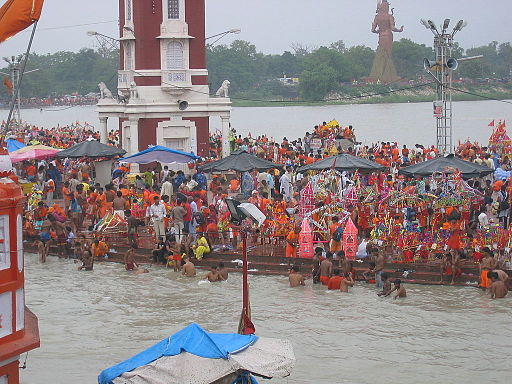THE HOLY KANWAR YATRA

- Country:
- India
The arrival of monsoon season marks the beginning of "The Kanwar Yatra" which takes place during the auspicious month of “Shravan” from July to August. It is a decades-old practice that was only performed by a few sages and devotees of Lord Shiva back in the 1960s. But in the early 1990s, local people also started participating in the holy Kanwar Yatra, and thus it became known around the world.
Now, it is that time of the year when you can see thousands of Lord Shiva Devotees wearing Saffron clothes, carrying "Kanwar" (a small pole of bamboo with earthen pots hung on either side) on their shoulders, and walking barefoot while loudly chanting “Bam-Bam Bhole” during the whole course of the yatra.
The story behind the practice of the Kanwar Yatra will leave you mesmerized.
According to ancient Hindu mythologies, it is believed that the “Samundra Manthan'' or churning of the sea was done by joint efforts of the Gods (Devtas) and the Demons (Danwas) to see who was the strongest among them. During the whole ritual of churning of the ocean, 14 kinds of pious things and umpteen gems and jewels along with Halahal (poison) emerged from the sea. The poison was just too strong for both the Devtas and Danawas to consume, and that’s when Lord Shiva came to the rescue and drank all of Halhal storing it in his throat which made his throat appear blue and because of this he is famously known as “Neelkanth” (the one with the blue throat).To stop the poison from dripping down his throat Lord Shiva placed a crescent moon on his head and to tame the effect of the poison, all the gods or Devtas started offering holy water from the river Ganges.
And thus the tradition of offering the holy water aka Gangajal of the river Ganges to Lord Shiva in the month of Shravan has been going on ever since.
During the Kanwar Yatra, the devotees of Lord Shiva visit pilgrimage places like Gaumukh and Gangotri, in Uttarakhand and Haridwar to get the holy Gangajal from the Ganges river for offerings. To facilitate the devotees on this religious journey, several camps with services like free medical help, food, and water are set up along the way. The Kanwariyas make sure that their Kanwars never touch the ground during the course of the yatra to keep the Gangajal inside the earthen pots pure and holy.
Upon reaching their respective places, the holy water is poured on “Shivalingas” in the Shiva temples as offerings by the devotees to Lord Shiva for blessing their lives.
- READ MORE ON:
- Kanwar Yatra
- NeelKanth
- Lord Shiva
- Shravan
- Haridwar
- Mythology










